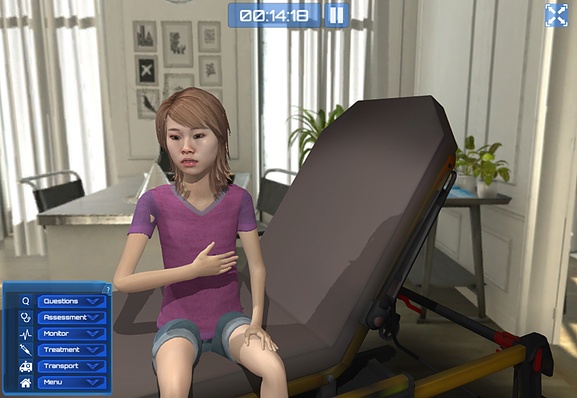
Pocket Nurse® featured Virtual Education Systems (VES), which provides interactive clinical scenarios, at our booth at the International Meeting on Simulation in Healthcare (IMSH) this year. (Pocket Nurse is a distributor for VES.) I was able to test the latest version of their VRPatients virtual reality (VR) software on the HTC Vive.
The experience was surprisingly immersive, which I hadn’t expected while watching on the display screen. Despite the level of detail and excellent overall visual quality, I had expected my mind to immediately reject a computer-generated environment.
Instead, I found myself concerned with my footing when I accidentally used my remote to jump onto the window ledge outside of the hospital room. I’m not great with heights.
My other concern before trying the system was that I’d experience motion-sickness. I had heard about issues with the Oculus Rift VR headgear due to the perception of motion while physically remaining still. Thankfully, the mechanics to look around the room were very smooth, and the Vive relies on jumping from spot to spot rather than gradual motion.

The system itself seemed very useful for students learning to assess patient discomfort. When confronted with my patient, Mr. Hawthorne, I was given a list of questions to ask him about what pain he was experiencing, when it began, and what he was doing at the time.
I was also able to monitor his vital signs using a floating monitor in my environment. His blood pressure was especially low, so I put pads on him by selecting them on a menu. I then began pacing his heart.
Once he was stabilized, I selected “Transport” from the menu, and after a brief loading screen, I was standing beside my patient in an ambulance. The attention to detail was apparent once again. An analog clock sat above the rear doors to my left. Mr. Hawthorne continued looking around from his stretcher. The seatbelt on the bench across from me even had a realistic buckle.
After the simulation was complete, I returned to the free range hospital room. Mr. Hawthorne sat on the bed. In front of me was a table with two brown vials, a book titled “Cancer,” and a working penlight. I was prompted to retrieve the penlight using the Vive wand. By applying pressure to the trigger, I was able to grasp the light and guide it into Mr. Hawthorne’s eyes. As the light hit his pupil, it constricted just like a normal eye would.
Pulling off my headgear, I readjusted to the real world quickly. If I were a student with access to this technology, I’d be eager to go to class every day. It was immersive, engaging, and genuinely fun.
Evan Stiger is the Marketing Coordinator at Pocket Nurse.






